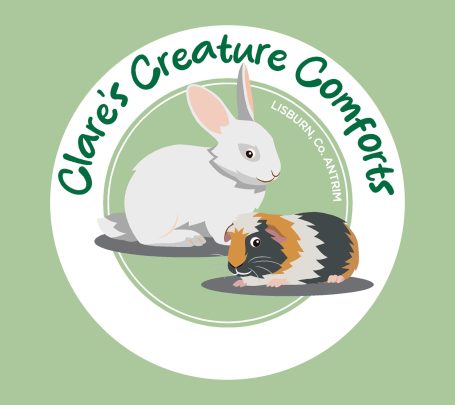
Rabbit Education
Research is such an important first step before you take the leap into adopting or buying any animal but rabbits needs in particular tend to be misunderstood. Rabbits make amazing family pets if you know about their needs and understand their behaviours.
Rabbits come in many different breeds, all with different colours, sizes, shapes, and coat types. Rabbits can vary in size from the smaller dwarf breeds weighing less than 2.5 pounds to some of the giant breeds, weighing in at a whopping 20 pounds or more!
Different breeds of rabbits
There are lots of different breeds of rabbits, quite how many different breeds depends on who you ask, what country you live in and depends on if you class in cross bread rabbits or just rabbits that are "show worthy". Rather than go into detail about lots of different breeds we have chosen to give information on the most common breeds we see here at CCC. Please also remember that this is a guide about how the breeds typically behave but just like with any animal they all have their own personalities and behavioural traits!
Netherland dwarf
The Netherland Dwarf comes in 25 different colours, including black, blue, chinchilla, chestnut, chocolate, fawn, Himalayan, lilac, orange, steel, tortoiseshell, blue-eyed white, and ruby-eyed white. Weighing in at a maximum of 2.5 pounds when fully grown they are one of the smallest rabbit breeds. They are an energetic and lively breed and they often form very close and strong connections with their owners. This breed can sometimes be skittish due to their high energy levels. If you have young children we would advise you to consider if this breed is best suited as it can take time for them to trust and be confident with people.
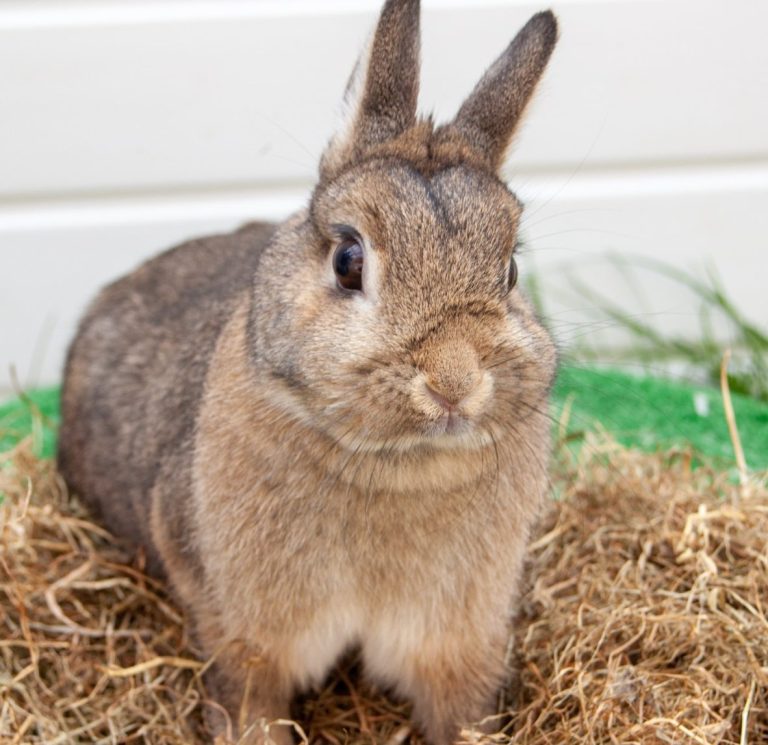

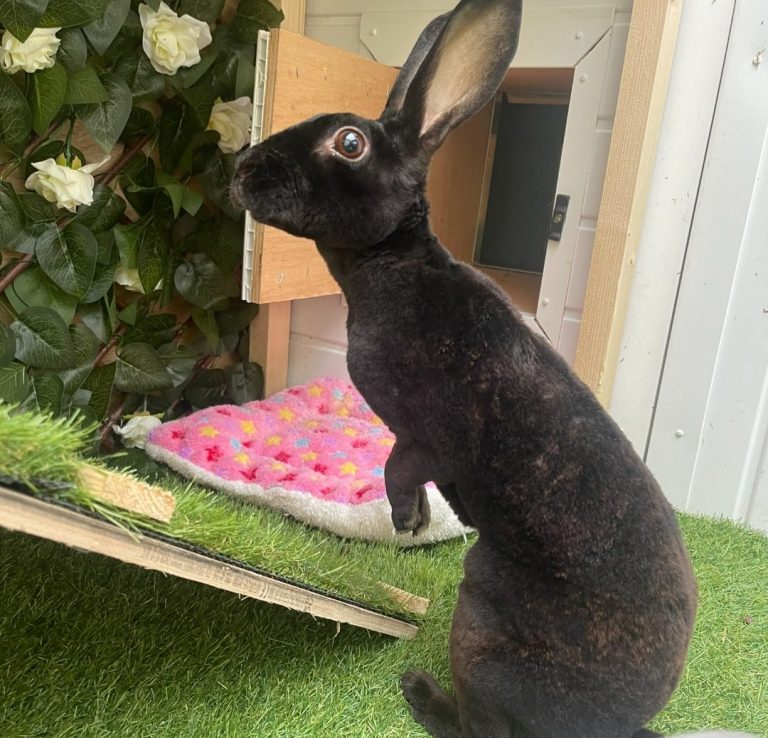
Mini Lop
The Mini Lop is a small, lopped-eared rabbit breed. Its body is small and stocky. Weighing between 4.5 to 6.5 pounds when fully grown, Mini Lops are larger than the Holland Lop but smaller than both the English Lop and French Lop. Mini lops are typically energetic and playful rabbits and tend to be what most people picture when you say "pet rabbit". We would advise you to consider vet costs before buying or adopting this breed as they can be prone to ear infections and dental problems.
Rex rabbit
The Rex rabbit is known for their velvety, plush, soft fur, which is short and dense, lending to its unique feel. The luxurious coat comes in 16 colour varieties. Typically weighing between 7.5 to 10.5 pounds when fully grown. This breed is typically known to be playful and outgoing but also patient and docile. We would advise you to consider the ongoing costs of vet check-ups as with all rabbits.
Lionhead
The lionhead rabbit is a petite breed with a distinctive fluffy wool mane similar to that of a male lion. Their body is compact, but their erect ears are large. This breed is typically friendly, playful, and social with humans and other rabbits. Weighing no more than 4 pounds when fully grown. We would advise you to consider your commitment to the ongoing lifelong grooming needs this breed has.

Flemish giant
Flemish giant rabbits are often nicknamed “the Gentle Giants” due to their extremely sweet temperament, the Flemish Giant is an exceptional pet. However, their is no weight limit on this bread and they can weigh up to 20+ pounds when fully grown. We would advise you to consider the space you have to offer before buying or adopting this breed.
Continental giant
It is believed that the Continental rabbit is likely related to the Flemish Giant. They come in white and coloured varieties, and are a large breed, weighing up to 16 pounds when fully grown. These rabbits are typically friendly, intelligent and easy to train, due to their large nature they also tend to be much more laid back than dwarf breeds. We would advise you to consider the space you have to offer before buying or adopting this breed.
Holland lop
The Holland Lop is a dwarf rabbit breed with lop ears. It has a large head relative to its body, and small dropped ears. They are typically docile and easier to handle than some of the larger lop breeds. They typically weigh less than 4 pounds when fully grown. We would advise you to consider the cost of certain vet visits as this breed can be prone to ear infections and dental issues.
Angora
Angora rabbits are known for their silky wool coats, known as Angora wool. Their amazing coats require a lot of care, including frequent brushing to prevent or remove mats, as well as plucking, shearing, or clipping the coat every few months. There are several Angora rabbit breeds, including the English Angora, French Angora, Giant Angora, and Satin Angora. They typically weigh between 5 - 10 pounds when fully grown. These rabbits are typically placid and enjoy spending time with humans. We would advise you to consider your commitment to the consistent and lifelong grooming needs that this breed has.


Rabbits Diet
It is important that rabbits have a balanced and nutritious diet throughout their lifespan. A rabbits diet should consist of at least 80% fresh hay, daily fresh greens, high quality pellets (we use excel burgess rabbit pellets) with just the occasional treat thrown in (we like using selective naturals loops). One thing we are always asked is ways in which you can get your rabbits to eat more hay, we recommend adding a sprinkling of forage mix to make it more interesting for your rabbit. You can also try using different types of hay.
The importance of spaying & neutering
Spaying or neutering your rabbit is an important decision to consider before adopting or buying. If you would like to bond your rabbit with another rabbit then spaying/neutering can help calm hormones and make bonding easier. There are other benefits to spaying/neutering even if you decide to just keep a lone bunny.
Benefits of spaying/neutering
- Prevents unwanted litters and controls the rabbit population
- Makes rabbits easier to litter train
- Reduces aggressive/hormonal behaviour
- Extends the rabbits lifespan
- Reduces the risk of cancers and UTI's
Anesthetising rabbits is much more high risk than anesthetising cats or dogs. Something to talk about with your vet about is the risk of putting your rabbit under anaesthesia especially if your rabbit is at high risk. Below we have linked an amazing informational page written by Orchard Vets (who are based in England) that explains the risk of putting rabbits under anaesthetic and what vets do to reduce these risks. Your own vet can give you more information and can help you weigh up the risk vs benefits of any given procedure for your specific rabbit.
Did you know that according to research up to 80% of female rabbits will develop uterine cancer by the age of 5 years old if they are not spayed - this can significantly reduce their life span.


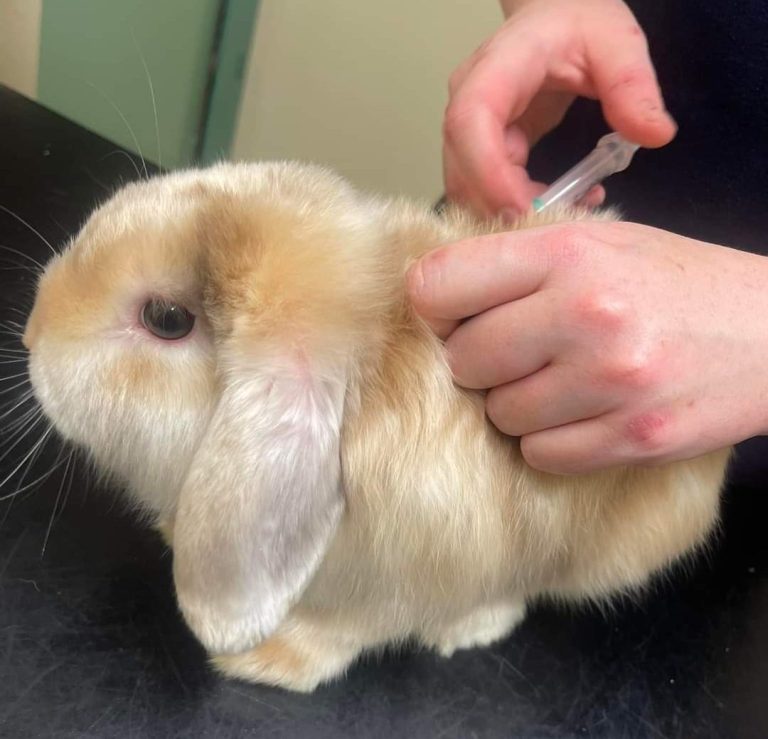
Rabbit Vaccinations
All rabbits should be vaccinated to protect against RVHD1, RVHD2 and Myxomatosis. All these diseases are fatal if your rabbit catches them. All the rabbits at CCC are vaccinated before finding their furever homes.
Rabbits are normally eligible for the 3 in 1 vaccine but your vet may also choose to give the vaccine in individual doses. The 3 in 1 vaccine typically costs around £60 per rabbit depending on the vet and covers your rabbit for 12 months after this a booster must be given to ensure continued protection.
If you receive government benefits you may be entitled to free or heavily discounted care from the PDSA. We have linked their eligibility criteria at the bottom of this page so you can check to see if you are able to receive care/discounts from them.
Below we have also linked the RSPCA vaccine information page where you can read more about the diseases the vaccine protects against.
Orchard vets anasthetic risk page
PDSA Eligibility Criteria
RSPCA rabbit vaccination page
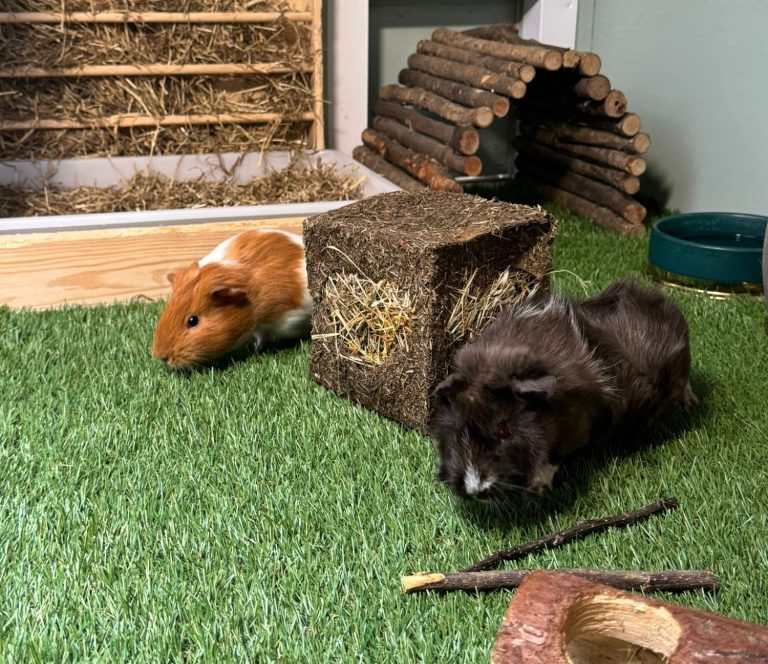
Guinea Pig Education
Research is such an important first step before you take the leap into adopting or buying any animal but guinea pigs needs in particular tend to be misunderstood. Guinea pigs make amazing family pets if you know about their needs and understand their behaviours.
Guinea pigs come in many different breeds, all with different colours, sizes, shapes, and coat types. Guinea pigs should always be kept with at least one other guinea pig for company.

Guinea Pig Breeds
Guinea pigs are intelligent and communicative pets. They can make fantastic family pets given time and if you understand some of their basic behaviours. On average guinea pigs live 5-6 years so they are a big commitment.
Guinea pigs come in all different sizes, coat types and colours. There are far too many types for us to list on this web page. The British Cavy Council recognise over 40 different breeds of guinea pig. At CCC we encourage you to do research into the specific breed or breeds you are interested in adopting.
Outlined below is general advice and care guidelines relating to diet, medical care and housing that are applicable to all guinea pigs.
Female guinea pigs are called sows and male guinea pigs are called boars. Groupings of guinea pigs can be complicated but as a general rule boars (males) should only be kept in a pairs. Where as sows (females) can be kept in large groups. You can also place a neutered male guinea pig in with a group of female guinea pigs.

Guinea pig diet
It is important that guinea pigs have a balanced and nutritious diet throughout their lifespan. A guinea pigs diet should consist of at least 80% fresh hay, daily fresh greens, high quality pellets (we recommend excel burgess guinea pig pellets) with just the occasional treat thrown in (we like using selective naturals loops). One thing we are always asked is ways in which you can get your guinea pig to eat more hay. We recommend adding a sprinkling of forage mix to make it more interesting for your guinea pigs as this encourages more natural behaviour. You can also try using different types of hay.

Guinea Pig Health
Guinea pigs are amazing pets but you need to make sure you are keeping on top of their health. As guinea pigs are pray animals they will naturally hide signs of disease or pain. One way you can ensure that you catch any issues early is to health check your guinea pigs once a week. This health check is quick and easy and can be done in a few minutes.
You should check:
- their teeth and nails are not overgrown (if nails are overgrown you can cut them, however, teeth issues should always be checked out by your vet)
-once every 3 months you should apply a guinea pig safe fly strike prevention spray
- check fur around their back end to ensure the area is clear and clean
- take your guinea pigs for a health check with a vet at least once a year
Housing requirements
Laid out in this graphic are the minimum housing requirements based on how many guinea pigs you have. It should be noted that these are minimum requirements so you need to meet these for the welfare of your guinea pigs. However, any space you can give them above and beyond this is ideal and you will notice your guinea pigs coming out of their shell more!
In addition to these requirements you should also aim to provide a few spaces to hide and comfortable bedding.
Unlimited hay should always be available 24/7 inside their enclosure. Foraging mix and toys are also a great addition to help enrich their lives.


Hamster Education
Research is such an important first step before you take the leap into adopting or buying any animal but hamsters needs in particular tend to be misunderstood.
There are 5 main domesticated species of hamsters so doing research on what species of hamster is right for you is just as important as knowing how to care for them.

Different species of Hamster
There are only 5 domesticated species of Hamster.
All Hamsters have an average lifespan of 1.5-2 years, the oldest ever recorded hamster lived to 4.5 years old.
Syrian Hamster
Syrian hamsters are sometimes referred to as the golden hamsters. Syrian hamsters are the largest of all the hamster breeds measuring between 5-7 inches long and weighing 120-200g. Syrian hamsters are solitary and must live on their own. They are known for their calm nature and often make great pets for kids as they are bigger and easier to handle.
Chinese Hamster
Chinese hamsters are long and thin looking and can look similar to a mouse. They are easier to distinguish from the other hamster types as they have a longer tail. They normally grow to be 3-5inches long and typically weigh 30-45g. They are solitary and must live on their own.
Russian Campbells Dwarf
Russian Campbells dwarf hamsters are the most common mini hamster breed. They measure 3-4inches when fully grown and weigh 30-50g. They come in lots of different colourings and patterns. We would advise that these hamsters live on their own.
Winter White Dwarf
The winter white dwarf hamster sometimes known as the Siberian hamster. Winter whites change their colouring in the winter to a snowy white colour and back to their original colouring in spring/summer. They measure 3-4 inches long when fully grown and normally weigh 30-50g. We would advise that these hamsters live on their own.
Roborovski dwarf
The Roborovski dwarf hamster is the smallest of all the hamster breeds. They measure 1.5-2 inches long when fully grown and normally weigh 20-25g. They can be difficult to tame and we wouldn't recommend this species for beginners. We would advise that these hamster live on their own.
Hamster Diets
As pets, hamsters need a good-quality, balanced and varied diet containing all the essential nutrients and minerals they need. In the wild, hamsters naturally eat a mixture of seeds, cereals, insect larvae and larger insects such as crickets.
We recommend any species specific complete hamster food as a nutritionally balanced base diet for hamsters. Bunny nature hamster dream is a great example of this and make great species specific food. In addition to this we also recommend feeding hamster safe proteins, veggies, fruits, nuts & seeds as treats and enrichment.
We also recommend hamster safe sprays and millet scattered throughout their enclosure for enrichment and encouraging natural foraging behaviour.
Hamster safe foraging mix & scatter feeding can also be a great way to enrich your hamsters life.

Housing requirements
The minimum enclosure dimensions are based on scientific research by a team of scientists based out of Germany. They found that hamsters thrive when their enclosures meet & exceed the following dimensions:
4000sqcm for dwarf hamster species.
5000sqcm for Syrian Hamsters.
The larger you can make your hamsters enclosure the better.
Dwarf hamster species wheel height should be 21cm and Syrian hamsters wheel height should be 28cm.
Most pet shop cages/enclosures do not meet these requirements and their can be a lot of conflicting information online.
Essential elements to include in your hamsters enclosure:
- an appropriately sized wheel (see above)
- 8-12 inches of hamster safe bedding as hamsters love to burrow and hide!
- plenty of appropriate and different hides
- water bottle/bowl
- foraging toys and activities
- chew toys to keep their teeth healthy
- Tunnels and ladders
- sand baths (this is how they keep their fur cleanand healthy)

For more specialised and in depth care advice click here
We need your consent to load the translations
We use a third-party service to translate the website content that may collect data about your activity. Please review the details in the privacy policy and accept the service to view the translations.
